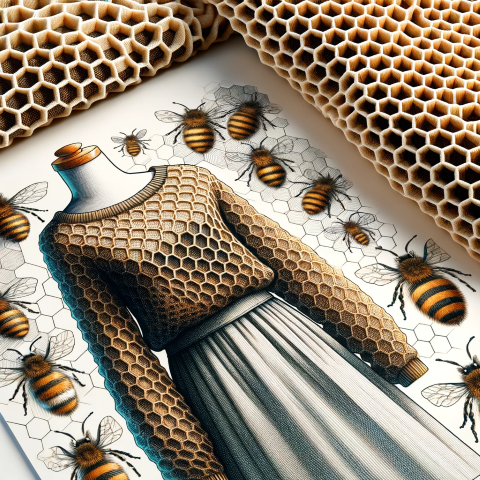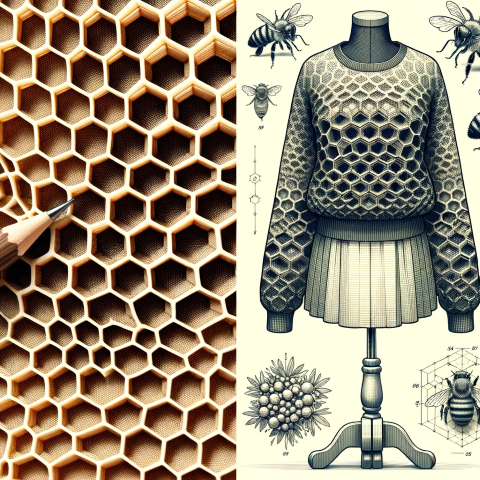Last Updated on: 16-Feb-2024 (5 months, 11 days ago)
Share on Facebook • Share on Twitter
The honeycomb pattern is created by interlocking two or more warp yarns with a single weft yarn. This results in a raised hexagonal shape, which can be filled in with additional yarns to create a three-dimensional, cushion-like texture. The structure of honeycomb fabrics makes them highly absorbent, as well as warm and breathable.
Honeycomb fabrics can be made from a variety of fibers, including cotton, wool, linen, and synthetic materials such as polyester. Cotton honeycomb fabrics are particularly popular for towels and blankets, as they are soft, absorbent, and durable. Wool honeycomb fabrics are used in a range of garments, including sweaters and coats, as they provide warmth and insulation without being too heavy.
One of the unique properties of honeycomb fabrics is their ability to trap air between the raised hexagonal shapes, creating a layer of insulation. This makes honeycomb fabrics particularly popular for use in bedding, as they provide warmth without being too heavy or bulky. They are also used in upholstery and drapery, as they add texture and interest to a room.
Honeycomb fabrics are often used in combination with other textures, such as smooth or ribbed fabrics, to create contrast and interest. They are also popular for use in color blocking, as the hexagonal shapes provide a unique canvas for bold color choices.
Top manufacturers of honeycomb fabrics include companies such as Welspun, Trident, and Dunroven House. These companies produce honeycomb fabrics in a variety of colors and textures, ranging from soft and subtle to bold and bright. They are sold to a range of industries, including hospitality, home goods, and fashion.
One of the key uses of honeycomb fabrics is in the production of towels. Honeycomb towels are highly absorbent, lightweight, and quick-drying, making them ideal for use in bathrooms, spas, and gyms. They are also a popular choice for beach towels, as the honeycomb texture allows sand to easily shake off.
Honeycomb fabrics are also used in the production of bedding, including sheets, pillowcases, and blankets. The lightweight and breathable nature of honeycomb fabrics makes them ideal for use in warm weather, while the insulating properties make them perfect for cooler temperatures.
In the fashion industry, honeycomb fabrics are used in a range of garments, including sweaters, jackets, and scarves. They provide warmth and insulation without adding bulk, making them a popular choice for outdoor activities such as hiking and skiing. Honeycomb fabrics can also be used as a design feature in accessories such as handbags and hats, adding texture and interest to an outfit.
In conclusion, honeycomb is a unique texture in textiles that provides a distinctive look and feel. It is created by interlocking warp yarns with a single weft yarn, resulting in a raised hexagonal shape that can be filled in to create a three-dimensional texture. Honeycomb fabrics are highly absorbent, warm, and breathable, making them popular for use in a wide range of textiles, including towels, bedding, and fashion. Top manufacturers of honeycomb fabrics include Welspun, Trident, and Dunroven House, and they are sold to a range of industries, including hospitality, home goods, and fashion.
�A float weave made in many fabrics. The name comes from a French word meaning birds nest. Its patterns are regular and open. Honey comb fabric is also known as Diamond Weave. It is found in draperies, jackets and women's clothing.
Some more terms:
Tack spitter
In the textile industry, various tools and equipment are employed to enhance efficiency and accuracy during production processes. One such device is the tack spitter, an essential tool used for...
Read about Tack spitterKhaki
Literally a color description given to yellow-brown, earth/dust tones or greenish tinged shades, the term khaki has also evolved to define a strong cloth made of cotton, worsted or linen yarns and...
Read about KhakiCreep
In the context of textiles, "creep" refers to the gradual deformation or elongation that occurs in a fabric or fiber over time when it is subjected to a constant load or stress. It is a property of...
Read about CreepAbrasion Mark
Abrasion Mark is a term commonly used in the textile industry to describe visible marks or damage caused by friction or rubbing on a fabric's surface. It refers to the physical wear and tear that...
Read about Abrasion MarkPolylactic Acid Fiber
(PLA Fiber) A synthetic substance produced from the fermentation of plant sugars derived primarily from corn, which is then made into a fiber. Lightweight, hypoallergenic, and providing more UV...
Read about Polylactic Acid FiberApron dress
An apron dress is a versatile garment that combines the functionality of an apron with the style and design elements of a dress. It is a synonym for neckties and is widely used in the textile...
Read about Apron dressCottagora Unveiled: From Ancient Charms to Modern Allure
An extremely soft and environmentally sound material made from a combination of Angora rabbit hair and organic cotton. Unlike traditional Angora, cottagora can be machine washed and dried. It is also...
Read about CottagoraCut and Sew
A system of manufacturing in which shaped pieces are cut from a layer of fabric and stitched together to form garments. In the case of tubular knitted fabric, the cloth is either cut down one side...
Read about Cut and SewAdd a definition
- The term you want to define
- Its definition in 500 words or less
- Attach an image if necessary.
- Optionally, tell us about yourself in 200 words or less!
Companies for Honeycomb:
- Company name
- Company address
- Attach a logo, if necessary.
- Optionally, tell us about yourself in 200 words or less!

 Vietnam has a robust textile education system, producing skilled professionals for the industry.
Vietnam has a robust textile education system, producing skilled professionals for the industry.

